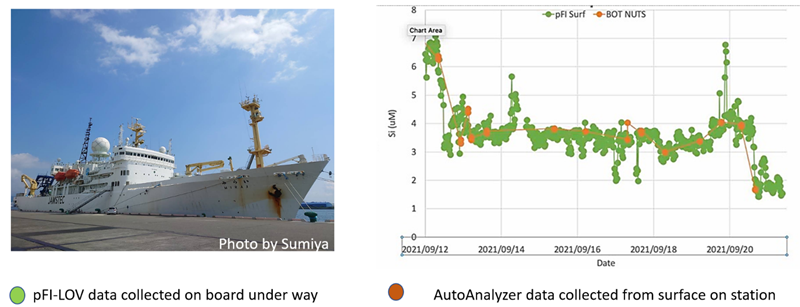3.4. Conclusion
Now, with all information at hand the relevant question is whether flow programming, can be viewed as a harbinger of a new generation of Flow Injection, or if it offers only a marginal improvement of this method. It also can be objected that it is too early to tell, because we are comparing merits of cFI, developed over half a century with capabilities of pFI developed within last 5 years (references 1-6 below). But since the goal of Advances is to promote recent developments, such comparison is justified.
In cFI format manifold must be tailored to optimize performance of any individual reagent based assay, and therefore a variety of flow systems must be designed to accommodate a variety of reagent-based assays. In pFI-LOV format, on the other hand, the same Lab-on-valve manifold will accommodate single as well as multi reagent assays, because their performance is optimized by means of flow programming. Also, by replacing variety “spaghetti like” manifolds with a standard, compact monolithic structure mounted atop a multiposition valve, makes assay conditions, controlled by software protocol, well reproduced. This will result in improved correlation of data obtained on different pFI-LOV instruments and in different laboratories.
In continuous flow format the carrier steam is made of reagents which are therefore continuously consumed. In pFI format carrier stream is made of DI water. This not only saves reagents while flow channel is periodically rinsed with DI water, but it also positions absorbance measurements on well-defined and reproducible baseline. This is because zero absorbance value is established at the beginning of every assay cycle when flow cell is filled with deionized water. This facilitates the correlation of absorbance measurements obtained with different methods and on different instruments.
Should these features be deemed only as improvement of performance of continuous flow method, pFI will fail the Hansen’s ultimate test:
The ultimate test for an analytical method is not that it can do better what can be done by other means, but that it permits us to do something that we cannot do in any other way.
Elo H. Hansen
However, Autocalibration by Single Standard Solution and DI water based Calibration Line method permits us to do what cannot be done in any other way than by programmable FI.
We are, at this time, only at the beginning of development of pFI and therefore its features outlined here, and documented in publications 1 to 6 are limited to assays based on spectrophotometry and designed to obtain high sensitivity with aim to determine trace nutrients in sea water. But in the future the range of applications will, in analogy with past developments of cFI and SI, expand to pharmacology, biochemistry, agrochemistry and other fields . Since Lab-on-valve manifold is compatible with flow cells from 1cm up to 50 cm in length, sensitivity of spectrophotometric determinations can be adjusted accordingly. LOV furnished with flow cells for fluorescence (Grand 2016) and for chemiluminiscence facilitated in the past use of these techniques in SIA format.
The first real life application of pFI is taking place while this Conclusion is being written (September 2021). Continuous monitoring of dissolved silica on board of Japanese research ship Mirai during a cruise in Behring Sea, where salinity varied from 25 to 32 psu, is conducted by Mariko Hatta by means of pFI augmented by DI water based Single Standard Calibration method. The research is a part of the Arctic Challenge for Sustainability II project.

Invention of FIA was prompted, 40 years ago, by need to determine nutrients in soil. Similarly, this time its further development is prompted by need to advance methods for determination of traces of nutrients in sea water . We hope that further applications of pFI will follow the same path as FIA did; from tool for serial assays to means of enhancement of analytical methods.
“Flow injection analysis is more than analytical technique. It is a technology that provides a platform for the use of most analytical methods.”
G. D. Christian and A. Townshend
Benefit of using FIA as “front end” to sensors, detectors, and instruments is the automation of sample handling, cleanup, preconcentration, and data collection. Now pFI offers three (and perhaps more) desirable features: Single Solution Standard Calibration, Autodilution, and Batch-flow sample processing. In the next Chapter we will present along with flow programming, applied to chromatography also hybrid systems where SI and pFI serve as ‘front end’ to liquid chromatography.
We hope that this Tutorial will inspire others to pursue opportunities offered by flow programming.
[1] J.Ruzicka “Redesigning flow injection after 40 years of development: Flow Programming” Talanta 176 (2018) 437–443.
[2] M. Hatta, C.I. Measures, J. Ruzicka, “Programmable Flow Injection. Principle, methodology and application for trace analysis of iron in sea water matrix.” Talanta 178, (2018) 698.
[3] J. Ruzicka, G. D. Marshall, Ch. Measures, M. Hatta“ Flow injection programmed to function in batch mode is used to determine molar absorptivity and to investigate the phosphomolybdenum blue method “Talanta 201 (2019) 519–526
[4] M. Hatta., Ch. I. Measures, J. Ruzicka “Determination of traces of phosphate in sea water automated by programmable flow injection: Surfactant enhancement of the phosphomolybdenum blue response” Talanta 191 (2019) 333–341
[5] M. Hatta., J. Ruzicka, Ch. I. Measures “The performance of a new linear light path flow cell is compared with a liquid core waveguide and the linear cell is used for spectrophotometric determination of nitrite in sea water at nanomolar concentrations “ Talanta 219 (2020) 121240
[6] M. Hatta, J. Ruzicka, Ch. I. Measures , M. Davis Programmable flow injection in batch mode: Determination of nutrients in sea water by using a single, salinity independent calibration line, obtained with standards prepared in distilled water “Talanta 232 (2021) 122354
[7] M. M. Grand, P. Chocholous, J. Ruzicka, P. Solich, Ch.L. Measures, “Determination of trace zinc in sea water by coupling solid phase extraction and fluorescence detection in the Lab-On-Valve format” Anal. Chim. Acta 923 (2016) 45-64.